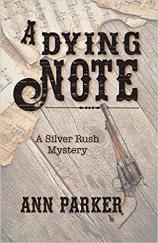Author Talk: April 18, 2018
Ann Parker’s award-winning Silver Rush mystery series features saloon owner Inez Stannert in the 1880s silver boomtown of Leadville, Colorado. In this interview, Parker describes the extensive research she conducted for the sixth and latest installment, A DYING NOTE, in which Inez moves her base of operations from Leadville to San Francisco. She also talks about her inspiration for merging the historical western and crime genres, some memorable feedback she has received from readers about her novels, and the opportunity she has created by choosing a title that does not rhyme (unlike the previous five books in the series).
Question: The Silver Rush series seems to work equally well as a group of historical westerns and as a mystery. When you conceived of the series, did you view it primarily as one or the other?
Ann Parker: When I originally considered dipping a toe into the world of fiction, I focused on the possibility of writing a mystery, as that is a genre I read and loved. I was casting about for a protagonist and setting that captured my imagination, when my Uncle Walt told me that my paternal grandmother had been raised in Leadville, Colorado. This bit of family history was news to me! He then told me a little about Leadville’s “hell-raising” history. I was intrigued, to say the least. After researching the Silver Rush period of Leadville, I decided to base a mystery set in that time and place. Long answer to a short question: I have always viewed the series as historical mysteries set in the West. So I’m certainly happy having a foot in both camps.
Q: In the new novel, A DYING NOTE, which is the sixth in the series, protagonist Inez Stannert has moved from Leadville, Colorado, to San Francisco. Given that you now reside in the Bay Area, what kind of research did you have to conduct to move Inez's base of operations to the California of 1881?
AP: All kinds! (That’s the short answer to a long question.) True, I’m a San Francisco Bay Area native --- even now, I only live about 30 miles from where I was born and raised --- but I’ve never lived in San Francisco and only really started exploring the area when it became time to research Inez’s new location. Early on, I journeyed to the San Francisco Main Library, visited its History Center, and got myself a library card. City maps and directories from the era, newspapers, census data… it all became grist for the mill as I tried to get a handle on what San Francisco was like and what was going on in my timeframe of interest. The library also has a wonderful online historical photograph collection that I referred to often from the comfort of my home.
In addition, I turned to a dear friend of mine, San Francisco resident and enthusiast Colleen Casey, and raided her extensive personal library. Colleen was the recipient of many frantic late-night emails, and we had interesting back-and-forths about topics as diverse as the labor scene in 1881, the local schools back then, which streets were on hills, should it be “Kearney” or “Kearny,” etc. I also plunked down the cash to spend a night in San Francisco so I could walk the streets of interest. For instance, Inez’s music store is on the corner of Pine and Kearney, and it was imperative that I “walk the walk” from there to Lincoln School, where Inez’s ward Antonia went to school.
That’s only the tip of the iceberg, of course. I also had to research the music scene during those times, music stores, the labor movement, and so on. Additionally, as I launched into this, it struck me that I was leaving most of my beloved secondary characters behind in Leadville. So I had to rebuild a new cast of characters, in addition to researching the new world that Inez inhabited.
Q: In an increasingly crowded field of mystery novels, the Silver Rush series seems to be nearly alone in merging the historical western genre with the crime genre. What inspired you to approach these books in that manner?
AP: My love of both genres as well as family history certainly came into play. There were a couple of other factors at work, and serendipity, as always, played a part. I saw room for overlap between mysteries, westerns and women-led stories.
When I was quite young and watching those 1950s and ’60s westerns, and later, as I read some of the western classics such as SHANE, something became VERY clear to me, even that early on: The guys were having all the fun! They were the ones having adventures, chasing the bad guys, escaping from danger (on their own!), and so on. And they were the ones who grandly rode off into the sunset, as the womenfolk stayed behind, languishing on the homesteads or in the saloons. To me, it just didn’t seem fair at all.
Also, in the 1990s, when I was beginning to consider writing fiction, the history of women in the American West was becoming a topic of academic interest. I thought it would be fun (because if it isn’t fun, why do it?) to create a strong female protagonist --- reflecting many of the strengths and stories that were coming to light at that time --- place her in the tumultuous West I loved as a child, and set her solving complicated mysteries like the ones I enjoyed as an adult. I looked around, and the mystery series that came closest to what I fancied was Dianne Day’s Fremont Jones series, which had a lighter “feel” than the series I wanted to create. The field, as you say, was wide open.
Q: When you receive feedback from your readers, do they seem to hail from both the western and mystery camps? What has been some of your favorite reader suggestions?
AP: They seem to come from both, which makes me happy. As for suggestions from readers, I have SO many favorites! Some folks contact me to share bits of their family history. It’s amazing how many people have past family ties to Leadville and Colorado. Probably one of my favorite stories came from a UK reader who recorded oral histories. She mentioned one history of a miner from the Devon/Cornwall area who emigrated in 1881, came to own a silver mine, died in Denver, Colorado, and had his body shipped backed to Cornwall in a glass coffin for burial! I had never heard of coffins made of glass, and that sent me off on a bit of research that proved useful in WHAT GOLD BUYS, the prequel to A DYING NOTE.
I’m also forever grateful to the Civil War historian/reenactor who, back when SILVER LIES first came out, contacted me and gently pointed out that I had inadvertently added a safety to a revolver. (Note to self: revolvers do NOT have safeties!) We started an active correspondence, and he invited me (and my family) to a Civil War reenactment, which provided some nifty background and historical tidbits for the second book in the series, IRON TIES.
Q: As a reader growing up, which writers did you cut your teeth on in both the western and crime categories?
AP: As a young’un, I leaned toward Edgar Allan Poe (for his beautiful use of language and the shivers-up-the-spine atmosphere) and Sherlock Holmes (for the clever clues and plots). As for westerns, I gravitated toward movies and television classics such as “Gunsmoke” and “Have Gun - Will Travel.” (I only have to hear “Ballad of Paladin” to be transported back to those days of lying on the rug in front of the black and white television.) I also was an avid consumer of the original “The Wild Wild West,” which was an energetic smash-up of western and spy genres with a good dose of mystery/who-done-it thrown in for fun. After that, I fell hard and heavy for the spaghetti westerns, especially Clint Eastwood’s Man with No Name movies (A Fistful of Dollars, For a Few Dollars More, etc.).
Q: Is it a problem that this sixth novel in the series is the only one that doesn't boast a title that rhymes?
AP: Well, you could say it’s a problem and an opportunity. I suspect fans would be alerted by the change in title scheme that “something is different,” which also is pretty clear from the book description and the first pages. But the metal/rhyming titles were also a little confusing; keeping the titles straight was a problem. Is it “Silver Ties”? “Mercury’s Lies”? And so on. Also, it was getting more and more difficult to come up with titles that tied to the plots and themes. More than one reader has suggested “Silken Thighs” as a future title. As I’ve told them, only in your dreams!




